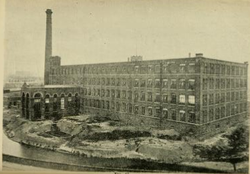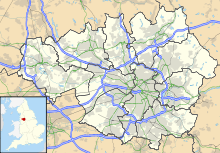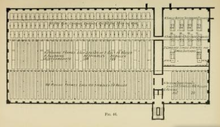- Minerva Mill, Ashton-under-Lyne
-
Coordinates: 53°28′56″N 2°05′18″W / 53.4823°N -2.0882°E
Minerva Mill 
Minerva Mill (1895)Cotton Spinning (mule mill) and doubling Serving canal Huddersfield Narrow Canal Serving Railway Lancashire and Yorkshire Railway Minerva Spinning Company Ltd. Coordinates 53°28′56″N 2°05′18″W / 53.4823°N -2.0882°E Construction Built 1891 Completed Feb 1892 Demolished 1937 Floor count 4 Other dimensions 283ft X Main contractor E. J. Smethurst Oldham Power Date 1892 Construction Firm Daniel Adamsons Engine Type Twin triple expansion rpm 55 Boiler configuration Pressure 11.249 bar Equipment Manufacturer John Hetherington and Sons, Mule Frames 86,868 spindles(1892)
93,828 spindles(1903)
Medium counts
+22,000 doubling spindles (1920)References Haynes 1987, p. 48 Minerva Mill was a cotton spinning mill in Ashton-under-Lyne, Greater Manchester, England. It was built between 1891 and 1892 for the Minerva Spinning Company which was later known as the Ashton Syndicate. Minerva Mill was next to the later Texas mill, at Whitelands. It ceased spinning cotton in the 1920s and was demolished in 1937.
Contents
Location
Minerva mill was built in a bend in the River Tame, close to the Huddersfield Narrow Canal, at Whitelands. It was at the end of Minerva Road.
History
The Minerva Spinning Company Limited was registered in 1891 to build the Minerva Mill at Whitelands. The directors were Messrs Barlow, Marland, Coop, Newton, Pollitt and Pownall; they were later referred to as the Ashton syndicate. The syndicate went on to build the Rock Mill, Atlas Mill, Curzon Mill, Tudor Mill, Cedar Mill and finally the adjoining Texas Mill. The Minerva Spinning Company went out of business in the 1920s.[1]
Architecture
Four storeys over a basement.
Power
The steam engine was a 1500 hp twin triple expansion engine by Daniel Adamsons, of Openshaw built in 1906. The cylinders were christened Capital and Labour. It had a 18 ft flywheel that operated at 75 rpm. The flywheel drove 40 ropes that transmitted the power to each floor. The cylinders all had Corliss valves. They had a 48in throw, the High pressure was 22 ½" in diameter, the intermediate was 34 in and the low pressure was 56in. The air pump was driven from the low pressure crosshead, there was a Saxon governor on the high pressure end of the bed.[2]
Equipment
The mule frames were provided by John Hetherington and Sons Ltd. On startup here were 86,868 mule spindles spinning medium counts from American cotton, that was 40's twists and 65 wefts. By 1903, this had increased to 93828, and by 1920, 22,000 doubling spindles had been added.[3] In order to run these spindles in the spinning rooms, the cotton had to be prepared using openers, scutchers, carding engines.
Equipment in Minerva Mill Number Machines Ratio 2 Vertical Openers and scutchers 1 : 43,434 4 Intermediate Scutchers 1 :21,717 93 Carding Engines 1 :934 63 finishing deliveries of drawing 1 :1,380 792 Slubbing spindles 1 :109.7 1716 Intemediate spindles 1 :50.6 6680 Roving spindles 1 :13 86,868 Mule spindles 1 :1 Usage
Minerva Mill was used for spinning fine counts of Egyptian cotton, both twists and weft.
Owners
- The Ashton syndicate
See also
References
- Notes
- ^ Haynes 1987, p. 481
- ^ Roberts 1921
- ^ Haynes 1987, p. 51
- ^ Nasmith 1895, p. 113
- Bibliography
- Haynes, Ian (1987). Cotton in Ashton. Libraries and Arts Committee, Tameside Metropolitan Borough. ISBN 0-904506-14-2.
- Nasmith, Joseph (1895). Recent Cotton Mill Construction and Engineering. London: John Heywood. ISBN 1-4021-4558-6. http://www.archive.org/stream/recentcottonmill00nasm/recentcottonmill00nasm_djvu.txt. Retrieved March 2009.
- Roberts, A S (1921). "Arthur Robert's Engine List". Arthur Roberts Black Book. (One guy from Barlick-Book Transcription). http://oneguyfrombarlick.co.uk/forum_topic.asp?TOPIC_ID=7926&FORUM_ID=99&CAT_ID=3&Forum_Title=Rare+Text+(Book+Transcriptions)&Topic_Title=ARTHUR+ROBERTS+ENGINE+LIST&whichpage=1&tmp=1#pid81483. Retrieved 2009-01-11
- Williams, Mike; Farnie (1992). Cotton Mills of Greater Manchester. Carnegie Publishing. ISBN 0-948789-89-1.
External links
Lancashire cotton Architects 
Engine makers Daniel Adamson · Ashton Frost · Ashworth & Parker · Bateman & Sherratt · Boulton & Watt · Browett & Lindley · Buckley & Taylor · Carel · Earnshaw & Holt · Goodfellow · Fairbairn · W & J Galloway & Sons · B Goodfellow · Hick, Hargreaves & Co · Benjamin Hick and Sons · John Musgrave & Sons · J & W McNaught · Petrie of Rochdale · George Saxon · Scott & Hodgson · Urmson & Thompson · Yates of Blackburn · Yates & Thom · Whilans · J & E Wood · Woolstenhulmes & RyeMachinery makers Brooks & Doxey · Butterworth & Dickinson · Curtis, Parr & Walton · Dobson & Barlow · John Hetherington & Sons · Joseph Hibbert · Howard & Bullough · Geo. Hattersley · Asa Lees · Mather & Platt · Parr, Curtis & Madely · Platt Brothers · Taylor, Lang & Co · Textile Machinery Makers Ltd · Tweedales & Smalley- Oldham Limiteds · Fine Spinners and Doublers · Lancashire Cotton Corporation · Courtaulds · Bagley & WrightIndustrial processes Textile manufacturing · Cotton-spinning machinery · Friction Spinning · Magnetic ring spinning · Open end spinning · Ring spinning · Spinning frame · Spinning jenny · Spinning mule · Water frame · Roberts Loom · Lancashire LoomLists of mills LCC mills · Bolton · Bury · Cheshire · Derbyshire · Lancashire · Manchester · Oldham · Rochdale · Salford · Stockport · Tameside · WiganMuseums Bury Pilot Mill, Bury · Wilton Mill, Radcliffe
Bolton Lancashire Manchester and Salford Oldham Ace Mill, Hollinwood · Blackridings Mill, Oldham · Dawn Mill, Shaw · Fox Mill, Hollinwood · Hawk Mill, Shaw · Heron Mill, Hollinwood · Junction Mill, Middleton Junction · Kent Mill, Chadderton · Laurel Mill, Middleton Junction · Magnet Mill, Chadderton · Majestic Mill, Waterhead · Manor Mill, Chadderton · Newby Mill, Shaw · Orme Mill, Waterhead · Regent Mill, Failsworth · Royd Mill, Oldham · Royton Ring Mill, Royton · Rutland Mill, Shaw · Textile Mill, Chadderton · Trent Mill, ShawRochdale Stockport Elder Mill, Romiley · Kingston Mill, Stockport · Palmer Mills, Stockport · Vernon Mill, Stockport · Welkin Mill, Lower BredburyTameside Atlas Mill, Ashton-under-Lyne · Cedar Mill, Ashton-under-Lyne · Rock Mill, Ashton-under-Lyne · Saxon Mill, Droylsden · Stalybridge Mill, Stalybridge · Texas Mill, Ashton-under-Lyne · Tudor Mill, Ashton-under-Lyne · Waterside Mill, Ashton-under-LyneWigan West Yorkshire Categories:- Buildings and structures demolished in 1937
- Textile mills in Tameside
Wikimedia Foundation. 2010.


